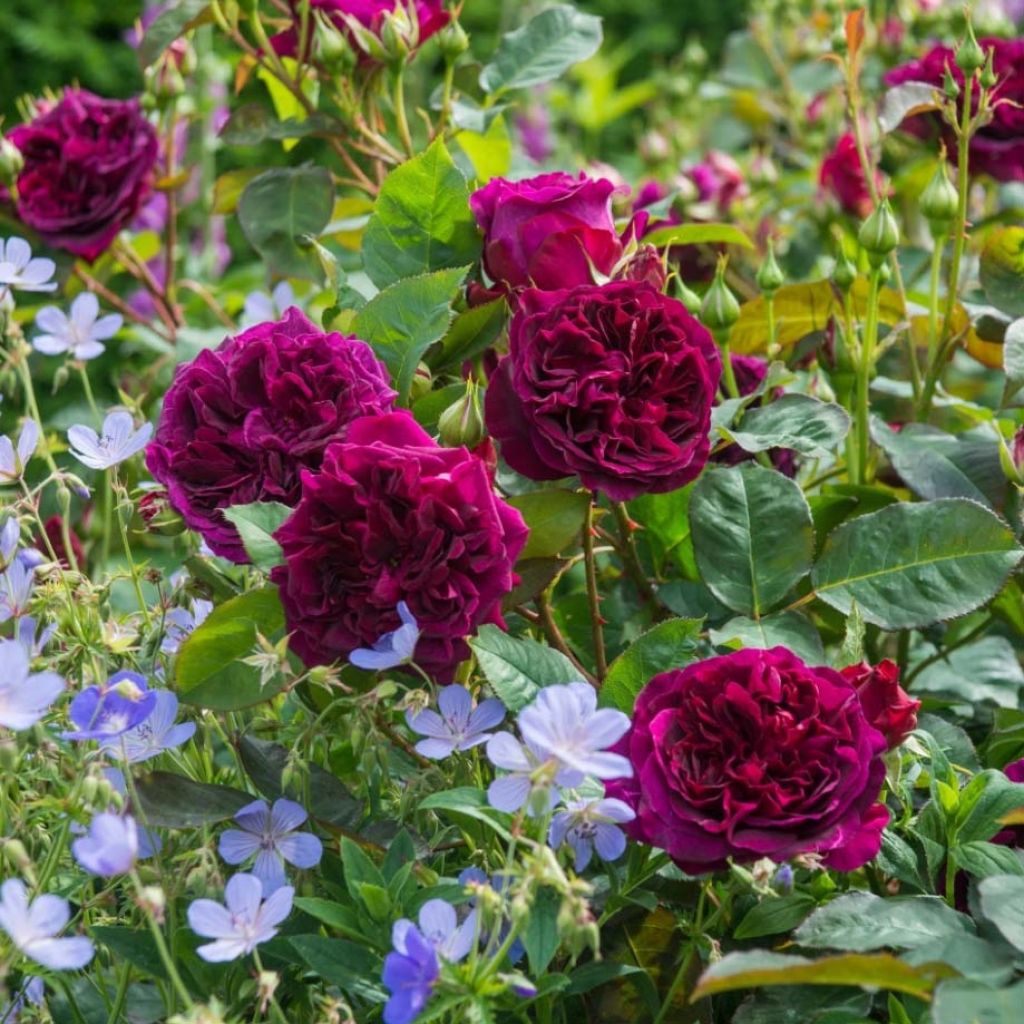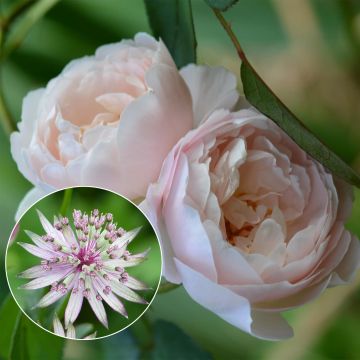

Cottage Duo - David Austin Munstead Wood rose and 3 perennial Blue Cloud Geranium
Cottage Duo - David Austin Munstead Wood rose and 3 perennial Blue Cloud Geranium
This plant carries a 12 months recovery warranty
More information
We guarantee the quality of our plants for a full growing cycle, and will replace at our expense any plant that fails to recover under normal climatic and planting conditions.
From €5.90 for pickup delivery and €6.90 for home delivery
Express home delivery from €8.90.
Delivery to Corse prohibited: UE law prohibits the import of this plant from mainland France to Corse as part of the fight against Xylella fastidiosa. Please accept our sincere apologies.
More information
Does this plant fit my garden?
Set up your Plantfit profile →
Collection items (4 plants)
Description
- 1 x David Austin Munstead Wood ® - Ausbernard ® Rosebush - Austiger: a bush with a fairly wide and low habit, 80-90 cm (32-35in) tall, mainly intended for borders, and flowering continuously from June to October, with large, very double flowers of a magnificent, intense purple and velvety colour. The strong fragrance emitted by the rose is also delightful, revealing warm and fruity notes of blueberries, blackberries, and plums.
- 3 x Blue Cloud perennial geranium: this variety has a spreading or climbing habit, reaching 40 to 70 cm (16 to 28in) in height, with a minimum spread of 90 cm (35in). Its flowering is particularly abundant, renewing itself from May to July-August and sometimes blooming again in autumn. The 4 cm (2in)-diameter flowers are a very soft grey-blue, almost crystalline, veined with purple. The plant produces diffuse and ramified stems that either creep along the ground or climb by taking support from neighbouring plants, but it does not root.
Preferably plant this Cottage Duo in the middle of a sunny flower bed or large border. There are plenty of combination ideas to create large flower beds according to each gardener's taste. You can enhance it with blue bell flowers, Damask nigellas, Bristol Fairy gypsophila (white) or Rosenschleier gypsophila (pink), or set it against cloud cabbage (Crambe cordifolia) and 'Powis Castle' shrubby Artemisia in a large English-style flower bed that will bloom for months. Also consider columbines and catmints. Roses are sturdy plants and the reputation of perennial geranium speaks for itself: once well established, this duo will only require regular dead-heading and winter pruning for the rose. The geranium will benefit from a little tidying up after the first wave of flowers.
Report an error about the product description
Flowering
Foliage
Plant habit
Botanical data
Cultivar or hybrid
Other Perennials Roses
Planting and care
Plant this collection in sun or partial shade in well-prepared, light, and well-drained soil.
Plant your English Rose Munstead Wood® in sun or light shade. English roses are tolerant of, but do not like excessive limestone. They will adapt to any garden as long as the soil is well-worked and rich enough. To plant your rose, work the soil by crumbling it and add fertiliser at the bottom of the planting hole, such as dried blood or dehydrated horn. Water generously after planting to remove any air pockets. Water regularly for a few weeks to facilitate rooting.
Pruning English roses is essential for flowering. At the end of winter, shorten the branches to 3-5 buds above the ground (at the lowest point), choosing outward-facing buds for a more elegant habit. Take advantage of this pruning to remove dead wood and unsightly branches. Prune at an angle above a bud. As the flowers bloom, deadhead them to stimulate the development of other buds.
Blue Cloud geranium: these prefer a sunny exposure, but tolerate partial shade. Plant them in fertile, well-drained soil that remains moist, even if it is limestone, acidic or clayey. To plant this perennial, work the soil to a depth of 20 cm (8in) by crumbling it and put a foundation fertiliser at the bottom of the planting hole, such as dried blood or dehydrated horn. Position your plants, removed from their pots, covering the top of the root ball with 3 cm (1in) of soil, fill in and water generously to remove any air pockets. In dry weather, water regularly for a few weeks to facilitate rooting.
Planting period
Intended location
Care
This item has not been reviewed yet - be the first to leave a review about it.
Haven't found what you were looking for?
Hardiness is the lowest winter temperature a plant can endure without suffering serious damage or even dying. However, hardiness is affected by location (a sheltered area, such as a patio), protection (winter cover) and soil type (hardiness is improved by well-drained soil).

Photo Sharing Terms & Conditions
In order to encourage gardeners to interact and share their experiences, Promesse de fleurs offers various media enabling content to be uploaded onto its Site - in particular via the ‘Photo sharing’ module.
The User agrees to refrain from:
- Posting any content that is illegal, prejudicial, insulting, racist, inciteful to hatred, revisionist, contrary to public decency, that infringes on privacy or on the privacy rights of third parties, in particular the publicity rights of persons and goods, intellectual property rights, or the right to privacy.
- Submitting content on behalf of a third party;
- Impersonate the identity of a third party and/or publish any personal information about a third party;
In general, the User undertakes to refrain from any unethical behaviour.
All Content (in particular text, comments, files, images, photos, videos, creative works, etc.), which may be subject to property or intellectual property rights, image or other private rights, shall remain the property of the User, subject to the limited rights granted by the terms of the licence granted by Promesse de fleurs as stated below. Users are at liberty to publish or not to publish such Content on the Site, notably via the ‘Photo Sharing’ facility, and accept that this Content shall be made public and freely accessible, notably on the Internet.
Users further acknowledge, undertake to have ,and guarantee that they hold all necessary rights and permissions to publish such material on the Site, in particular with regard to the legislation in force pertaining to any privacy, property, intellectual property, image, or contractual rights, or rights of any other nature. By publishing such Content on the Site, Users acknowledge accepting full liability as publishers of the Content within the meaning of the law, and grant Promesse de fleurs, free of charge, an inclusive, worldwide licence for the said Content for the entire duration of its publication, including all reproduction, representation, up/downloading, displaying, performing, transmission, and storage rights.
Users also grant permission for their name to be linked to the Content and accept that this link may not always be made available.
By engaging in posting material, Users consent to their Content becoming automatically accessible on the Internet, in particular on other sites and/or blogs and/or web pages of the Promesse de fleurs site, including in particular social pages and the Promesse de fleurs catalogue.
Users may secure the removal of entrusted content free of charge by issuing a simple request via our contact form.
The flowering period indicated on our website applies to countries and regions located in USDA zone 8 (France, the United Kingdom, Ireland, the Netherlands, etc.)
It will vary according to where you live:
- In zones 9 to 10 (Italy, Spain, Greece, etc.), flowering will occur about 2 to 4 weeks earlier.
- In zones 6 to 7 (Germany, Poland, Slovenia, and lower mountainous regions), flowering will be delayed by 2 to 3 weeks.
- In zone 5 (Central Europe, Scandinavia), blooming will be delayed by 3 to 5 weeks.
In temperate climates, pruning of spring-flowering shrubs (forsythia, spireas, etc.) should be done just after flowering.
Pruning of summer-flowering shrubs (Indian Lilac, Perovskia, etc.) can be done in winter or spring.
In cold regions as well as with frost-sensitive plants, avoid pruning too early when severe frosts may still occur.
The planting period indicated on our website applies to countries and regions located in USDA zone 8 (France, United Kingdom, Ireland, Netherlands).
It will vary according to where you live:
- In Mediterranean zones (Marseille, Madrid, Milan, etc.), autumn and winter are the best planting periods.
- In continental zones (Strasbourg, Munich, Vienna, etc.), delay planting by 2 to 3 weeks in spring and bring it forward by 2 to 4 weeks in autumn.
- In mountainous regions (the Alps, Pyrenees, Carpathians, etc.), it is best to plant in late spring (May-June) or late summer (August-September).
The harvesting period indicated on our website applies to countries and regions in USDA zone 8 (France, England, Ireland, the Netherlands).
In colder areas (Scandinavia, Poland, Austria...) fruit and vegetable harvests are likely to be delayed by 3-4 weeks.
In warmer areas (Italy, Spain, Greece, etc.), harvesting will probably take place earlier, depending on weather conditions.
The sowing periods indicated on our website apply to countries and regions within USDA Zone 8 (France, UK, Ireland, Netherlands).
In colder areas (Scandinavia, Poland, Austria...), delay any outdoor sowing by 3-4 weeks, or sow under glass.
In warmer climes (Italy, Spain, Greece, etc.), bring outdoor sowing forward by a few weeks.





































